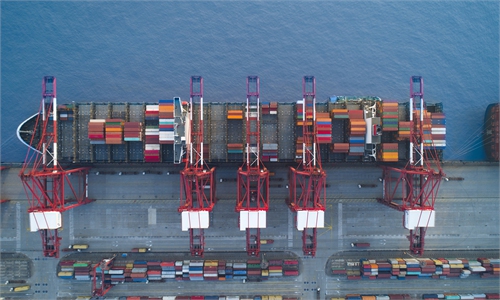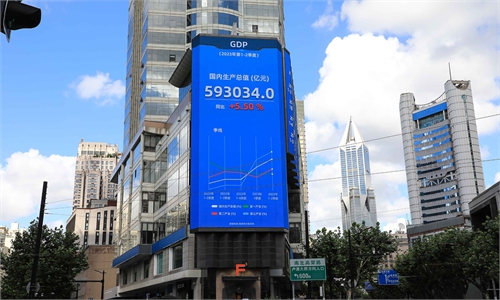
Lujiazui Photo:VCG
China's six largest economic powerhouse provinces had all released their first-half GDP data as of Sunday, showing solid expansion, with many growing faster than the national economy, amid a steady recovery despite domestic and external downward pressure.
As these powerhouses are crucial to China's economic recovery, they have been told by top officials to fully play their core roles in this process. Analysts said that these provincial economies, while also facing slowing down pressure, have the potential and ability to underpin China's second-half rebound.
Central China's Henan Province was the last of the six to announce its first-half data on Saturday. Henan, which is known for hosting manufacturing bases for giants such as Foxconn, reported 3.8 percent year-on-year growth to more than 3.13 trillion yuan ($44 billion), which ranked No.5 in China.
South China's Guangdong Province remained the nation's largest provincial economy, with GDP growing at 5 percent and reaching 6.29 trillion yuan. East China's Jiangsu Province expanded 6.6 percent to 6.05 trillion yuan. East China's Zhejiang Province grew by 6.8 percent, while Shandong's economy grew by 6.2 percent. The economic powerhouse in Southwest China, Sichuan Province, expanded 5.5 percent.
On average, the six provinces' first-half growth was 5.65 percent, slightly faster than the national rate of 5.5 percent. The six provinces' combined GDP accounted for more than 44 percent of China's total GDP in the first half.
"These economic powerhouses maintained a relatively high growth rate despite the pressure on exports, reflecting the evident recovery of the main part of the country's manufacturing industry. That drove their growth rate above the national averay," Cong Yi, dean of the School of Marxism at Tianjin University of Finance and Economics, told the Global Times on Sunday.
Also highlighting China's accelerated recovery, several provinces' growth rates sped up in the second quarter. Shandong's growth rate was 1.9 percentage points higher than the first quarter, Sichuan's rate was up 1.7 percentage points, Shandong's rate was up 1.5 percentage points, and Guangdong's rate was up 1 percentage points.
Nationally, GDP grew 6.3 percent year-on-year in the second quarter despite challenges, compared with 4.5 percent in the first quarter.
The headline economic data showed a deeper, more significant trend in some of the economic powerhouses such as Guangdong, Jiangsu and Zhejiang, which used to rely heavily on strong export sectors, according to Tian Yun, a Beijing-based economist.
"After three years of the epidemic, the upgrading of the industrial structure of these eastern coastal provinces may have found a way out," Tian told the Global Times on Sunday. "The main driver of growth shifted from exports to high value-added manufacturing."
Given the size of these economic powerhouses, top Chinese officials have called on them to take the lead in the country's economic recovery. As the rebound continues to face mounting domestic and foreign pressure, it is crucial for these provinces to be proactive to tackle the challenges and continue to lead the economic recovery in the second half, analysts said.
"After the three-year epidemic, the international situation has changed rapidly, and industries in several provinces need to have a new technological revolution, reinvent themselves and at the same time have certain policy support," Cong said, noting policies such as further tax and fee cuts for high-tech companies and small businesses could boost market vitality.
Based on the first-half data, which showed a steady recovery but also rising downward pressure, Chinese officials have promised strong policy support to boost growth, including monetary policy and support for the private economy. On Wednesday, China's top leadership issued a sweeping guideline on promoting the sound development of the private economy, vowing to further optimize the environment, offer more policy support and create favorable public opinion for the private sector, as well as promote sound development of entrepreneurs.
"In the second half, to achieve high-speed growth, we need to further expand demand," Tian said.
He also noted that China has the means and ability to deal with local government debts, which have become a topic for foreign media hype.




